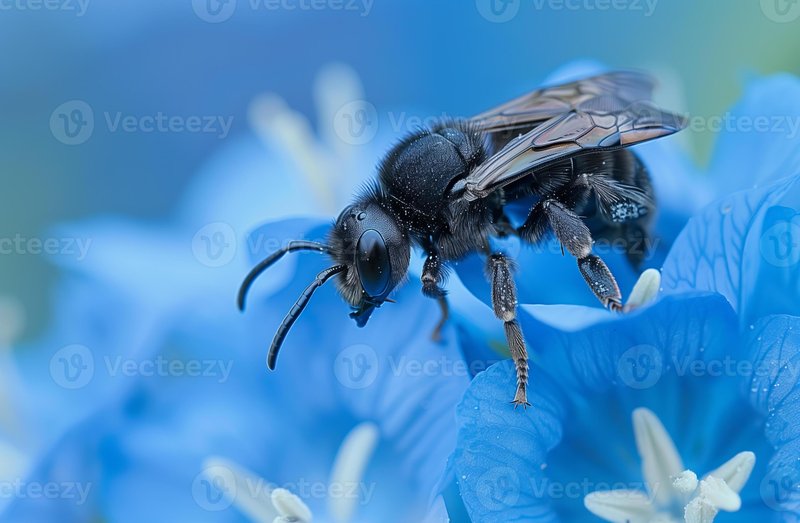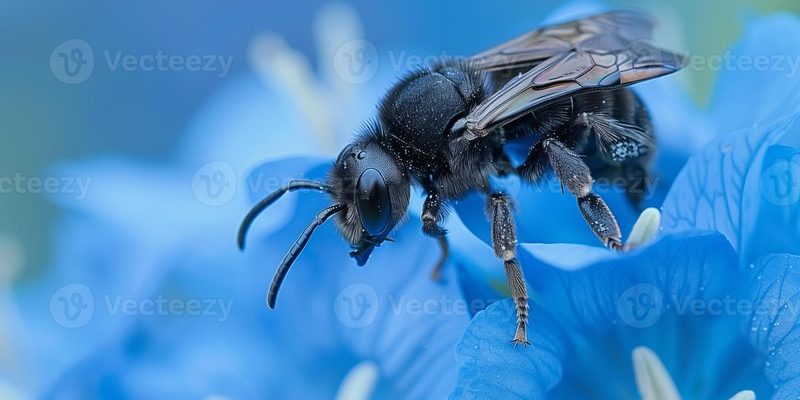
Have you ever noticed a chunky, fuzzy bee buzzing around your garden? That’s likely a carpenter bee, belonging to the genus Xylocopa. These fascinating insects play a significant role in our ecosystem, particularly when it comes to pollination. Unlike honeybees, carpenter bees are solitary creatures, and they have unique habits that set them apart from their more social cousins. Let’s dive into the world of Xylocopa, where we’ll explore their behavior, habitat, and why they are crucial for our environment.
Xylocopa, commonly known as carpenter bees, get their name from their habit of boring into wood to create nests. They are often mistaken for bumblebees due to their similar appearance, but there are key differences that make carpenter bees quite distinct. While bumblebees have a more rounded, hairy body, carpenter bees are typically slick and shiny, especially the males. Understanding these differences can help us appreciate their unique place in the insect world!
Physical Characteristics of Carpenter Bees
To truly appreciate carpenter bees, let’s look at their physical features. Carpenter bees are typically large, measuring around 1 to 2 inches in length. Their bodies are often covered in a mix of black and yellow hairs, giving them a fuzzy appearance. However, many species of carpenter bees have a shiny, hairless abdomen, especially the males. This shiny look can sometimes lead to confusion with bumblebees.
One notable adaptation is their strong mandibles. These powerful jaws allow them to bore into wood. They can create tunnels for nesting, which can be an advantage but can also lead to damage in wooden structures. Size and coloration can vary between different species, with some being more vibrant than others. For instance, the Eastern carpenter bee has a bright yellow and black coloration, while others may appear mostly black.
Life Cycle and Behavior
The life cycle of carpenter bees follows the typical format of many bees, but with some intriguing twists. These bees usually emerge in spring, ready to mate. Males are known for their territorial behavior, often buzzing around their preferred nesting sites to ward off other males. After mating, females begin the process of creating nests.
Females are the builders of their families. They select wood—often softwoods like pine, cedar, or redwood—and begin to drill into it. The tunnels they create can be several feet long and are used to house their eggs. Once inside, the female lays eggs in individual chambers and fills them with pollen and nectar to provide food for the larvae once they hatch. This solitary nesting behavior sets carpenter bees apart from more social bee species.
Habitat and Distribution
Carpenter bees can be found in various environments, but they have a particular fondness for sunny areas with plenty of blooming flowers. They prefer habitats that provide both suitable nesting sites and abundant food sources. As such, you’ll often find them in gardens, parks, and forests, where they can easily spot flowers from which to collect nectar.
These bees are present in nearly every region of the world, with a strong emphasis on tropical and temperate climates. In the United States, they are most commonly found in the eastern and southern states. The distribution of Xylocopa species varies, with some being more prevalent in certain areas than others.
| Characteristic | Detail |
| Size | 1 to 2 inches long |
| Habitat | Sunny areas with flowering plants |
| Diet | Nectar and pollen |
| Lifespan | 1 season, with some species surviving through winter |
Pollination Role
Carpenter bees, like many pollinators, play a critical role in our ecosystem. While they may not be as celebrated as honeybees, their contributions are just as important. As they move from flower to flower, collecting nectar, they unintentionally transfer pollen, helping plants reproduce. This process is vital for the growth of fruits and vegetables, as well as the health of flowering plants.
Interestingly, carpenter bees are particularly effective pollinators for certain types of plants. Their robust bodies can traverse flowers that other insects may find challenging to visit, ensuring that a diverse range of plants can thrive. This is especially important in agricultural settings, where crops depend on reliable pollination.
Common Misconceptions
There are several misconceptions about carpenter bees that can lead to unnecessary fear or misunderstanding. One common myth is that carpenter bees are aggressive. While it’s true that males may buzz around intruders, they do not have stingers and are generally harmless. Females can sting, but they usually only do so when threatened.
Another myth is that carpenter bees cause significant damage to wooden structures. While they can bore into wood, they often select areas that are already decaying or soft, which limits their impact. Most homeowners can manage any potential damage with simple preventive measures, such as painting wood surfaces or using treated lumber. Being informed about these gentle giants can help reduce fear and promote a better understanding of their role in our environment.
Conservation Efforts
In recent years, there has been a growing concern about the decline of bee populations worldwide, including carpenter bees. Habitat loss, pesticide use, and climate change are major threats that affect their survival. Many organizations are working hard to raise awareness and promote conservation efforts to protect these essential pollinators.
Creating bee-friendly gardens is one way you can help. Planting native flowers, avoiding pesticides, and providing nest sites can create a welcoming environment for carpenter bees and other pollinators. Educating others about the importance of preserving these species can make a significant difference. Every little action counts!
FAQ
Are carpenter bees aggressive?
Carpenter bees are not typically aggressive. Males, which lack stingers, may buzz around you to defend their territory, but they will not attack. Females possess a sting, but they are generally more docile and only sting when feeling threatened. These bees are more interested in finding food and nesting than bothering people.
How do carpenter bees build their nests?
Carpenter bees create nests by digging into wood, including fences, decks, and even trees. A female will choose a suitable piece of wood and use her strong mandibles to tunnel in, creating a series of chambers where she will lay her eggs. Each chamber is filled with a mixture of pollen and nectar to provide food for the developing larvae.
What can I do if I have carpenter bees in my yard?
If you find carpenter bees nesting in your yard, you can choose to leave them be, as they are beneficial pollinators. However, if they are causing damage, you may want to take preventive measures. Filling their holes with caulk or painting exposed wood can deter them. Additionally, providing alternative nesting sites, such as bee hotels, can encourage them to nest elsewhere.
Do carpenter bees pollinate?
Yes, carpenter bees are excellent pollinators. As they collect nectar from flowers, they inadvertently transfer pollen between plants, facilitating their reproduction. This makes them crucial for the health of ecosystems and agricultural success, as they contribute to the pollination of various crops and flowering plants.
What should I plant to attract carpenter bees?
To attract carpenter bees, consider planting native flowers that bloom throughout the growing season. Some great options include sunflowers, lavender, and bee balm. These plants not only provide food for the bees but also create an inviting habitat that can support a variety of beneficial insects.
How long do carpenter bees live?
The lifespan of carpenter bees varies, but they typically live only for one season. However, mated females can survive through the winter in their nests. The following spring, they emerge to lay eggs and continue the cycle of life. Each generation contributes to the ongoing health of their ecosystems.
Can carpenter bees damage my house?
While carpenter bees can bore into wood, the damage they cause is usually minor and primarily affects already decaying or soft wood. Taking preventive measures, like painting wood surfaces or using treated lumber, can significantly reduce the chances of carpenter bees nesting in your home. Regular maintenance can help keep your wooden structures safe from any potential damage.
Are carpenter bees endangered?
While they are not currently classified as endangered, carpenter bee populations face threats from habitat destruction and pesticide use. It’s essential to support conservation efforts and raise awareness to protect these vital pollinators. By creating bee-friendly environments and avoiding harmful chemicals, we can help ensure they thrive.
What distinguishes carpenter bees from bumblebees?
The most noticeable difference between carpenter bees and bumblebees is their appearance. Carpenter bees typically have a smooth, shiny abdomen, while bumblebees have a more rounded, furry body. Additionally, carpenter bees are usually solitary, whereas bumblebees live in colonies. Understanding these differences can help you appreciate the unique traits of each species.
How can I learn more about carpenter bees?
To learn more about carpenter bees, consider visiting local nature centers, reading books on pollinators, or exploring resources provided by conservation organizations. You can also observe these bees in your garden to appreciate their behavior and role in the ecosystem. Engaging with your local environment is one of the best ways to deepen your understanding!

